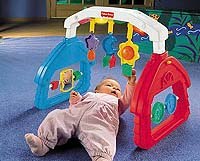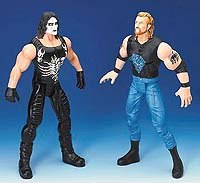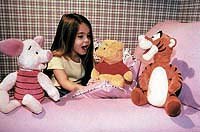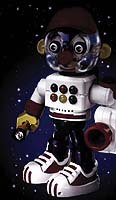Jacquie Kubin discovers a new realm where technology meets toys, and discusses the new delights that are in store for the upcoming holiday season.
Children need only but to look around to see the marvels of technology. From ATM machines to price scanners, youngsters are bombarded by this age of intelligent machines. As an obvious extension, toy makers are gearing up for this new age. A new trend, "the smart toy," can talk, respond, teach, interact and become part of a child's life. "The way I understand the smart toy, it is a toy with its own intelligence, programmed with electronics that allow a child to respond, and that will let the child know if they have responded correctly or not," says Kathleen Alfano, Ph.D. toy development for Fisher-Price. "Today's technology has allowed for many more smart toys because the price of that technology has decreased while the amount of information that can be put on a small chip has increased." Building Blocks To Learning Building blocks were one of the first toys ever developed and LEGO, which means "play well" in the native tongue of Danish founder Ole Kirk Christensen, may be the first "smart toy." LEGO, which was first introduced in 1947, was created to empower a child's imagination, creativity and motor skill development within an unlimited play potential arena. They increase a child's understanding of spatial relationships while helping them to develop reasoning and analytical skills without a single blinking light. The plastic building blocks have grown and changed over the years, and today LEGO is animated and responsive. For children twelve and older, LEGO has introduced a new building system that combines modern day technology with childhood play, Mindstorm's Robotic Invention System. Mindstorm puts the power of robotics at the command of the child as they build and program intelligent inventions that move, act and think on their own. The system works with a LEGO microcomputer and traditional LEGO elements to create new ways for children to interact with present day technology. With the 700 piece system, children can create everything from a light-sensitive intruder alarm to a robotic rover that can follow a trail, move around obstacles and duck into dark corners.

At the core of the system is the RCS, an autonomous LEGO microcomputer that can be programmed using a PC. Inventors first build their robot and create a program for that invention using RXC code, a simple programming language, that is downloaded to the RCX via an infrared transmitter ($200). Joining in on the largest toy licensing event of the decade, LEGO Mindstorms will release the Droid Developer Kit for the 1999 holiday season. With Droid Developer, young Skywalkers can build their own droids that move, chirp and respond to their environment. Droid Developers does not require that the inventor have a PC, though each kit comes with paper and CD-ROM instructions. Droids that can be built include the classic R2-D2 and the new battle droids introduced in this year's movie. Designed for builders ages nine and up, Droid Developers has three difficulty levels -- Apprentice, Jedi Knight and Jedi Master -- though most children will be able to complete their first working droid, the L-3GO, in less than one hour. Because of the modular building system, inventors will be able to mix and match sub-assemblies making it easy to create dozens of working droids. The Droid Developer Kit is powered by the Micro-Scout, the smallest LEGO microcomputer with built in light sensor, motor and seven behaviors. The kit contains over 600 pieces ($99).
Learning Through Smart Play
From the complex to the simple, smart toys are available for almost any age group and play pattern. "There are layers to the smart toy and some are very simple," says Dr. Alfano. "For babies, press a button and get a vocal response, for toddlers through first grade it may be simple reading, number, shape and color teaching toys that guide a child to make the correct response." Children's play and learning patterns are animated from birth by toys that respond to them. For infants to toddlers, learning begins with products that light up, make noise or create music with the lightest baby's touch.

Musical Lights 'n Sounds Gym (Fisher-Price, $30.00) provides infants a play experience wherein baby activates the sounds and songs by gently tapping on hanging sun, stars or moons. When activated a light display corresponds with the musical sounds for some early cause and effect teaching. Real world experiences can be brought into the home with smart toys like Scannin' Talkin' Check-Out Center (Fisher-Price, $27.99). This play center includes a conveyor belt that moves pretend grocery items to the cashier to be weighed and rung-up. This familiar toy teaches numbers, the ability to differentiate between items, counting money and manners as the electronic voice says, "Thank you" after each pretend purchase. One of the premier educational toy developers, LeapFrog believes in the "unlimited power that we all have to improve ourselves and others through lifelong learning. Smart toys are intuitive and fun products that bridge the gap between technology and toys," says Timothy M. Bender, vice president of sales, LeapFrog. "A lot of toy manufacturers are forgetting the traditional toy play patterns which have not changed. Today's 'smart toy' must include traditional stimulus and play pattern elements. Technology should not be used to replace play patterns, but enhance their play value. When a product just has sound or light or numbers -- it is not necessarily a smart product. You need to look at the education reward a child gets through the fun play."

One of the company's most exciting products, LeapPad, uses LeapFrog's patented NearTouch technology to bring paper books to life. NearTouch, used in many LeapFrog products, allows the toy to respond to a child's inquiry, such as "What word is this?" with no more than a touch of the "magic pen." Popular storytelling icons like 100 Acre Wood's Winnie the Pooh and Busy Town's Huckle Cat and Lowly Worm will be part of the LeapPad Library that will also have original content books to teach geography, science and music to children ages four and up. As children read through the books placed onto the LeapPad they can use the MagicPen to bring the words to life as LeapPad will read the story or identify letters or words to which the child points. Words are phonetically sounded out to promote reading development while children are allowed to learn and interact at their own pace. (LeapPad with 14 books $60.) Touted by the company as "The World's Most Intelligent Talking Globe," Explorer uses NearTouch technology to teach geography. When children point at a country, continent or ocean, the MagicPen Explorer identifies the area. Choose two points, and learn the distance and flying time between them. Explorer also offers information on an area's population, currency, music, time of day and more. Whole families will enjoy playing Explorer's interactive games. When children play by themselves, progressive helpful hints lead them to the correct answer. (Ages six through adult by LeapFrog $100.)

Just For Fun "Toys are becoming more and more interesting because as technology has grown it has enabled toy manufacturers to do more," explains Kathryn Maciel, vice president of marketing, Toy Biz. "This technology allows not only for the creation of toys that teach but also toys that are just fun; and there is room for both. There is always going to be a place for toys that children can use in imaginative play patterns just for the fun of it." Fans of the wrestling world will be able to recreate their favorite shouting and fighting matches from the ring with Tuff Talkin' Wrestlers. Toy Biz has used Smart Toy technology to animate twelve-inch articulated wrestlers in the image of Goldberg, Kevin Nash, Sting and Diamond Dallas Page (D.D.P.). Sold in two packs ($39.99), Goldberg vs. Nash and Sting vs. D.D.P., each figure features the actual voices of the WCW wrestlers saying over 100 phrases depending on the action of the child.
For instance, move Goldberg's right arm and he will say, "Whose next?" or leave him alone and hear, "The Jackhammer will get you next time." Play with two figures at the same time and they will identify and interact with each other giving the tough talk heard in the rings such as, "Nash, every man I've faced I've destroyed," says Goldberg, to which Nash will reply, "Goldberg, I'll beat you because I am just too sweet." The likeness to the real wrestler is uncanny. The wrestlers will react to the others' moves and taunts as their mouths move in synch with their speech. (Additional Tuff Talkin' Wrestlers are expected for the Holiday 1999 season.)

From Mattel comes a gentler animated character that interacts with the child. Chat Pals uses technology to bring 100 Acre Wood's friends Winnie the Pooh and Tigger to life. These soft plush figures will talk, listen and react to a child or each other as they engage in real conversation. Chat Pals tell jokes, play games, ask questions and encourage the child, and other Chat Pals, to sing songs with them. By combining microphone and radio frequency technology, Chat Pals can actually hear a child's response, turning their heads and looking at the child when they speak and responding when the child has finished speaking. ($40 each by Mattel for children ages 4 and up. Line up to be expanded with a Piglet Chat Pals in 2000.) Something Old Is New Again Toy Biz's My Pal 2000 uses advancements in technology to expand the abilities of an already existing and popular toy. "My Pal was introduced in 1992, selling more than 1 million units," says Ms. Maciel. "My Pal 2000 reintroduces this popular toy at a lower retail price of $39.95 with added features to the 1992 release that retailed for $50." My Pal 2000, for ages four and up, is voice activated and responds to the child with over 70 phrases and sounds. The 16 inch robot has his own backpack where children can store things and removable flashlight. When a child talks to My Pal he responds to the sound by moving his head, eyes, nose, ears and, when talking, mouth.

My Pal can play five games: three interactive games with the lights on his chest, baseball (My Pal pitches foam balls and a bat is included in the package), and catch. He can also act as a room sentry, declaring, "Halt, who goes there. What is the password?" "We all know how kids are about their room and how they want their privacy," says Ms. Maciel. "In our focus groups the kids love the fact that My Pal is there to protect their room and that one of the neat things about My Pal is that he teaches, but you can also play baseball and catch. The most important though is that he talks to you. My Pal was created to be a kid's best friend." Kids Will Still Be Kids "I have been testing children and their play for more than twenty years, and over the last few years, it is not uncommon for me to see a child look at a truck or a soft toy and say, 'What does it do?,'" explains Dr. Alfano. "Children and parents expect that most toys will do something, but they are not disappointed when they don't." And even though parents might see a Winnie the Pooh that knows their name as being more than a toy, Dr. Alfano assures us that children see these animated marvels as just toys. "A child that loses a stuffed animal that talks and interacts with them is going to be no more or less devastated than when he or she loses a favorite plush animal," says Dr. Alfano. "Look at the smart toy to see that it encourages the values you want, the learning, positive feelings and encouragement that you think are important for your child." JJacquie Kubin, a Washington, D.C.-based freelance writer and photo-journalist, covers all manner of toys from stuffed teddy bears to computer equipment. She enjoys covering pop culture, travel and music events. Personal career highlights include interviewing Steven Tyler of Aerosmith, numerous photo opportunities with present day diva, Cheryl Crow, and interviewing Spawn's Todd McFarlane more than any other working female journalist.







